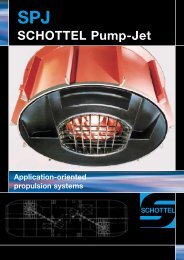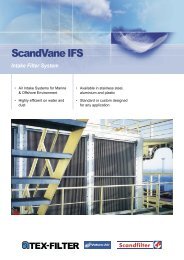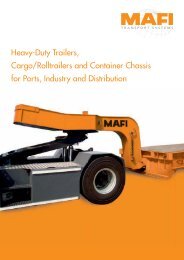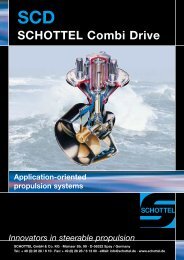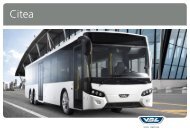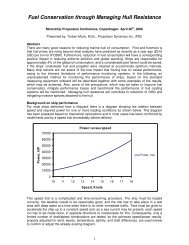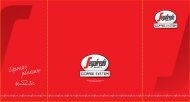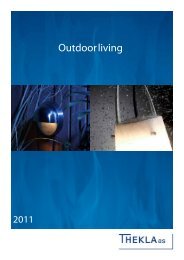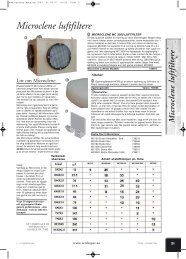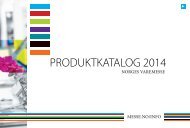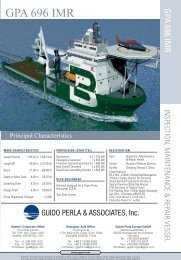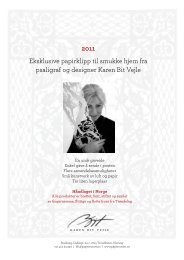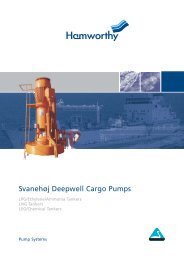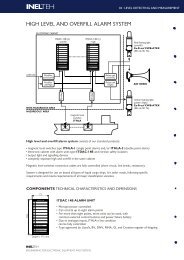DIWA.5 Combining Ride Comfort with Economy
DIWA.5 Combining Ride Comfort with Economy
DIWA.5 Combining Ride Comfort with Economy
You also want an ePaper? Increase the reach of your titles
YUMPU automatically turns print PDFs into web optimized ePapers that Google loves.
<strong>DIWA.5</strong><br />
<strong>Combining</strong> <strong>Ride</strong> <strong>Comfort</strong> <strong>with</strong> <strong>Economy</strong>
<strong>DIWA.5</strong>: The evolution of modern bus transmissions<br />
Starting, gear shifting, accelerating, gear shifting, braking, gear<br />
shifting: bus transmissions have a lot to endure. Especially <strong>with</strong> the<br />
start-stop conditions in inner-city traffic, but also on country roads<br />
and motorways. Therefore, over 200 000 buses worldwide have one<br />
thing in common: a DIWA automatic transmission from Voith Turbo.<br />
a<br />
Engine output<br />
0<br />
Starting range<br />
DIWA automatic transmission<br />
hydrodynamic proportion<br />
mechanical proportion<br />
a = gear shift<br />
Driving:<br />
power split <strong>with</strong> differential torque converter<br />
b<br />
a<br />
b<br />
Conventional automatic transmission<br />
Engine output<br />
0<br />
Starting range<br />
hydrodynamic proportion<br />
mechanical proportion<br />
a = gear-shift<br />
b = Closing of the lock-up<br />
Braking:<br />
retarder function <strong>with</strong> torque converter<br />
Wear reduction and comfort become visible –<br />
thanks to the flexible DIWA starting range<br />
The DIWA principle: driving and braking<br />
<strong>with</strong> one hydraulic circuit<br />
With the <strong>DIWA.5</strong> transmission, its E 300.1<br />
and its ALADIN diagnostic software,<br />
Voith offers the ideal solution for automatic<br />
transmissions in buses.<br />
The proven DIWA power-split principle allows<br />
smooth acceleration across a speed range where<br />
other transmissions need to shift gears two to<br />
three times. This makes DIWA the epitome of<br />
economical bus transmissions, up to 50 % fewer<br />
gearshifts means less wear and higher driving<br />
comfort.<br />
The elimination of external piping or hoses for<br />
the oil circulation and the heat exchanger built<br />
into the output cover are just a few features of<br />
the <strong>DIWA.5</strong> transmission. This makes it easy for<br />
vehicle manufacturers to build the transmission<br />
into the vehicle, even where space is at a premium.<br />
Operators benefit from high availability as<br />
well as low maintenance and operating costs.<br />
The DIWA D 884.5 is a valuable addition to the<br />
product line: When faced <strong>with</strong> meeting increased<br />
demands, for instance, in Bus Rapid Transit (BRT),<br />
the new DIWA D 884.5 represents the ideal<br />
solution for engine torques up to 1900 Nm.<br />
The DIWA D 884.5 is capable of handling almost<br />
20 % more engine torque and 10 % higher engine<br />
power – and that <strong>with</strong>in almost identical dimensions<br />
and only a slight increase in weight.<br />
2
Voith DIWA –<br />
<strong>Economy</strong> and comfort made to measure<br />
103<br />
753<br />
272,5 242<br />
886<br />
274 263<br />
Typical assembly dimensions of the Voith <strong>DIWA.5</strong> transmission<br />
(864.5 including connection flange, in mm)<br />
On the basis of individual criteria such as wear, weight distribution, noise levels,<br />
passenger compartment design, etc., bus manufacturers and operators often<br />
select highly different drive solutions and overall concepts for their vehicles.<br />
Voith Turbo is flexible to these needs and, in addition to its standard product<br />
range, also offers components for the adaptation to different engines and axles.<br />
Standard scope of supply<br />
n Voith DIWA standard transmission<br />
n Corrosion-resistant heat exchanger<br />
n Torsional vibration damper<br />
n Electronic control<br />
n Set of cables<br />
Additional program*<br />
n Connecting flanges between engine<br />
and transmission<br />
n Suspension flanges<br />
n Output flanges / yokes<br />
n Output angle drives<br />
n Pushbutton switch for gear selection<br />
n Permanent brake operating lever<br />
* These parts are not included in the standard delivery<br />
package, but can be supplied upon request.<br />
3
Design and operation of the DIWA transmission<br />
The mature design of Voith automatic transmissions is up-to-date <strong>with</strong><br />
the latest technological developments. It is simple, logical and clear.<br />
8 5 4 3 10 2 1 6 7 9<br />
Idling/neutral position,<br />
input clutch open<br />
Starting<br />
DIWA range (stepless), input<br />
clutch and turbine brake are<br />
closing: smooth start <strong>with</strong> high<br />
traction. Rapidly increasing<br />
mechanical power transmission<br />
via differential transmission<br />
(power-split principle).<br />
Illustrated: D 864.5<br />
1 Counter-rotating torque<br />
converter<br />
2 Impeller brake<br />
3 Direct gear clutch<br />
4 Differential gear<br />
5 Input clutch<br />
6 Epicyclical gear<br />
7 Planetary gear unit<br />
<strong>with</strong> lamellar brake for<br />
reverse gear/converter<br />
brake<br />
8 Torsional vibration<br />
damper<br />
9 Heat exchanger<br />
10 Overdrive clutch<br />
The heart of the DIWA transmission is the<br />
hydrodynamic counter-rotating torque converter.<br />
Situated in front of it are the impeller, the direct<br />
gear clutch, the differential transmission, the<br />
input clutch and the overdrive clutch. Behind<br />
the converter, an epicyclical gear combines the<br />
hydrodynamic and mechanical forces.<br />
The final set of epicyclical gears activates the<br />
reverse gear and, during braking, also the retarder.<br />
A hydraulic torsional vibration damper at the transmission<br />
input reduces engine vibrations effectively.<br />
Gear shifting occurs electro-hydraulically,<br />
<strong>with</strong> patented solenoid valves; the gear-shifting<br />
commands are placed by the control system.<br />
The heat exchanger of the Voith automatic transmission<br />
is integrated into the cooling circuit of the<br />
vehicle engine; generated heat is immediately dissipated.<br />
The transmission oil circuit is designed as<br />
a full flow system ensuring that the oil temperature<br />
and transmission components run and operate<br />
as cool as possible. Even when the vehicle’s<br />
cooling system is running hot, the temperature of<br />
the transmission remains relatively stable <strong>with</strong> no<br />
danger of overheating.<br />
Performance data <strong>DIWA.5</strong> transmission<br />
Types D 824.5 D 854.5 D 864.5 D 884.5<br />
Input power P 1max<br />
[kW] 180 220 290 320<br />
Input torque M 1max<br />
[Nm] 650 1 100 1 600 1 1 900<br />
Input speed n 1max<br />
[rpm] 2 500 2 500 2 500 2 200<br />
Retarder braking torque M BR<br />
[Nm] 2 000 2 2 000 2 2 000 2 2 000 2<br />
Transmission mass (dry)<br />
incl. retarder<br />
[kg]<br />
approx.<br />
329<br />
approx.<br />
334<br />
approx.<br />
339<br />
Max. vehicle weight [t] 15 28 28 34 3<br />
approx.<br />
344<br />
4<br />
1<br />
1 700 Nm under certain conditions<br />
2<br />
Maximum value, depending on retarder configuration<br />
3<br />
depending on the axle ratio
A transmission that sets standards for fuel consumption<br />
as well as service and maintenance costs<br />
Power flow during gear shifting<br />
and braking<br />
Overdrive<br />
Clutch for the overdrive closes,<br />
clutch for direct gear opens.<br />
Reversing (R)<br />
Power is transmitted hydrodynamically/mechanically<br />
just<br />
as during starting.<br />
Braking<br />
(Retarder function <strong>with</strong> the<br />
converter)<br />
The turbine wheel acts as axial<br />
pump which delivers oil against<br />
the stalled impeller and the guide<br />
wheel. Heat resulting from the<br />
conversion of kinetic energy is<br />
dissipated via the heat exchanger.<br />
n Active power flow<br />
n Rotating components<br />
n Locked rotating components<br />
n Stationary components<br />
n Clutch plates closed<br />
ANS – Automatic Neutral<br />
Switch<br />
In order to save fuel, the power<br />
flow between the engine and<br />
transmission, including the<br />
converter, is automatically<br />
interrupted when the vehicle<br />
is at a halt.<br />
In operating terms, fuel consumption plays a<br />
major role. The overdrive ensures that fuelfriendly<br />
engine speeds are achieved both in city<br />
and in longdistance traffic. This is also aided by<br />
the torsional vibration damper which protects the<br />
transmission from low speed engine vibrations.<br />
The oil circulates solely inside the transmission.<br />
The Voith <strong>DIWA.5</strong> is designed <strong>with</strong>out external<br />
oil hoses or pipes. This simplifies transmission<br />
installation and improves the overall reliability<br />
of the oil circuit saving service and maintenance<br />
costs.<br />
Filter replacement <strong>with</strong>out having to change<br />
the oil? Oil change intervals up to 180 000 km?<br />
Even that is possible <strong>with</strong> the <strong>DIWA.5</strong>, again<br />
helping to reduce maintenance costs.<br />
Reliability starts in the detail<br />
Specially developed sensors ensure that the<br />
transmission is extremely reliable. However,<br />
on those occasions when a sensor needs to be<br />
replaced they are all accessible from the top of<br />
the transmission reducing maintenance times.<br />
Installation space is scarce in buses. The compact<br />
outer dimensions (e. g. by omitting pipes<br />
and tubes) facilitate the installation of the transmission<br />
even in the most confined of spaces.<br />
Last but not least, transmission installation and<br />
removal times from the vehicle chassis are also<br />
significantly reduced – owing to the straightforward<br />
connection of the torsional vibration<br />
damper.<br />
Hydrodynamics are one of the core competences<br />
at Voith: that is why over 100 years of experience<br />
have been put into our converter, the key component<br />
of the DIWA transmission.<br />
5
E 300.1 –<br />
a new-generation transmission control<br />
The new E 300.1 transmission control adjusts itself optimally to its<br />
environment: whether it is the topography and the axle ratio, or the<br />
electronic architecture of a modern commercial vehicle.<br />
Previously:<br />
BASP 4<br />
BASP 3<br />
BASP 2<br />
BASP 1<br />
Engine speed<br />
SensoTop:<br />
SensoTop<br />
Engine speed<br />
SensoTop<br />
Intelligent control unit E 300.1<br />
SensoTop:<br />
topography-dependent shifting program<br />
The acceleration-dependent shifting programs<br />
common today take into consideration the axle<br />
ratio, the vehicle‘s acceleration and the load;<br />
However, the grade or slope that the vehicle is<br />
operating on can only be estimated. The <strong>DIWA.5</strong><br />
Electronic Control Unit (E 300.1) has been<br />
equipped <strong>with</strong> a maintenance-free inclination<br />
sensor that identifies the topography quickly and<br />
precisely. Only this feature allows the optimum<br />
adaptation of gear speeds to the prevailing<br />
condition at all times. The SensoTop topographydependent<br />
shifting program reduces fuel<br />
consumption by up to 7 % while providing even<br />
greater driving comfort by avoiding gear hunting –<br />
our contribution to the environment.<br />
and optimization of the vehicle operation or in<br />
the selection of a driveline that meets all requirements.<br />
The E 300.1 control includes the secondgeneration<br />
operating data recording system and<br />
thus the ability to obtain a more detailed analysis<br />
of the service conditions under which the vehicle<br />
and transmission are being used.<br />
Event storage<br />
The control unit not only reports failures, but also<br />
all detectable events which indicate wear, incorrect<br />
operation or the need for maintenance work.<br />
The thoroughness of the diagnostics offered<br />
by the E 300.1 enables a precise, detailed and<br />
therefore fast localization of the cause.<br />
Second-generation DIWA operating<br />
data recording<br />
The Voith DIWA transmission is the first automatic<br />
transmission for buses that has an operating<br />
data recording system. Operators and vehicle<br />
manufacturers have learned to appreciate this<br />
not just since yesterday – e. g. in the analysis<br />
CAN pushbutton switch and<br />
electronic type plate<br />
The CAN pushbutton switch is convenient to<br />
use, simple to install and extremely reliable.<br />
The Transmission Identification Module (TIM)<br />
offers optimum and automatic configuring of<br />
the E 300.1 control to the transmission.<br />
6
ALADIN – the user-friendly diagnostic software<br />
for the <strong>DIWA.5</strong> transmission<br />
The Aladin diagnosis and analysis software presents service and operating data in clear,<br />
compact and ready-to-print reports. All important information from the control unit is taken<br />
into account: Event storage, identification data, key data, operating data, standstill times,<br />
adaptation values and much more.<br />
Analysis and diagnosis software Event storage Key data and operating data<br />
n Simple, intuitive operation<br />
n Fast, detailed and precise<br />
diagnostics<br />
n Direct incorporation of repair<br />
instructions into OEM diagnostic<br />
systems possible<br />
The event storage can accommodate<br />
up to ten independent events.<br />
An event may be either a fault<br />
message, e. g. about a short circuit<br />
in the lead to a solenoid valve, or<br />
a low oil level alert, for instance.<br />
The operating data serve as a source<br />
of information about the vehicle and<br />
contribute significantly to optimizing<br />
the driveline design, reducing operating<br />
costs and increasing availability.<br />
The data are recorded, classified and<br />
accumulated by the electronic control<br />
unit during the entire time that the<br />
transmission is in operation. In addition,<br />
vehicle-specific key data are derived<br />
from the operating data.<br />
Your benefits<br />
n<br />
Less time required for diagnostics<br />
n<br />
Minimization of standstill times<br />
n<br />
Reduction in fuel consumption<br />
n<br />
Ability to plan maintenance and servicing<br />
n<br />
Increased vehicle availability<br />
n<br />
Lower operating costs<br />
7
Voith Turbo GmbH & Co. KG<br />
Bus Drive Systems<br />
Alexanderstraße 2<br />
89522 Heidenheim, Germany<br />
Tel.: +49 7321 37-8579<br />
Fax: +49 7321 37-7818<br />
diwa@voith.com<br />
www.voithturbo.com<br />
G 1747 e KO/WA 09/2010. Print run: 2000, Dimensions and illustrations <strong>with</strong>out obligation. Subject to modifications.



